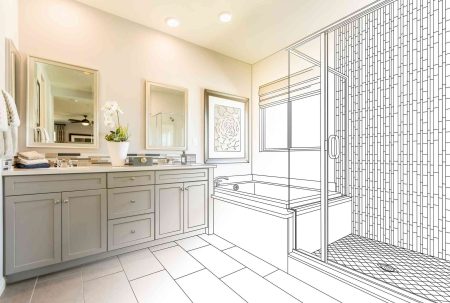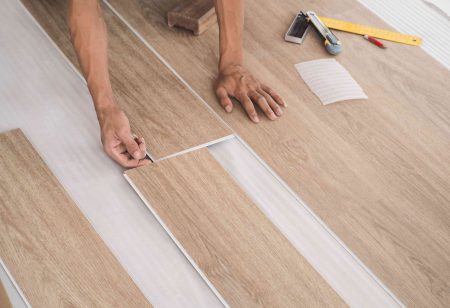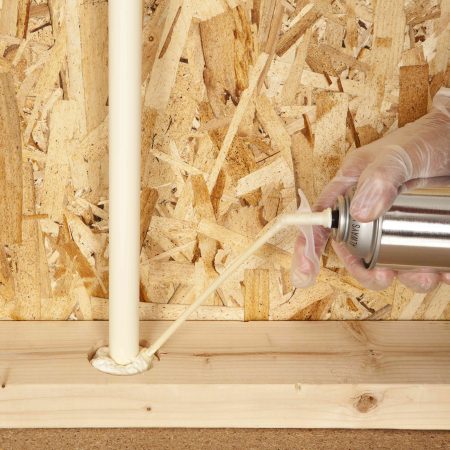Learning how to build garage shelves is a great way to add storage to your home on a budget. Even small garages offer space to store infrequently used items. But without a proper shelving system, things can get messy. Adding garage shelves is an inexpensive way to move items off the floor, organize them, and display them for easier access. Making the shelves yourself is much cheaper than buying a pre-fabricated shelving unit.
Here’s how to add garage shelving with just 2x4s, plywood, and basic power tools in under a day.
Before You Begin
Consider the type of items you will need to store, sizes, and frequency of use. Enough space—particularly height—needs to be allotted for them. Build garage shelves as a dense matrix of storage totes or as open shelves that are more freeform.
Garage Shelves for Storage Totes
Designing garage shelves around storage totes maximizes the shelves’ storage capacity and helps protect items. This project is designed around a popular type of container: 27-gallon plastic storage totes, each about 15-1/2 inches tall. The garage shelves are 32 inches deep, 8 feet wide, and 8 feet tall. Five shelves stack four totes across for a total of 20 totes.
| Standard Tote Sizes | |||
|---|---|---|---|
| Length | Width | Height | Volume |
| 19.1 inches | 12.7 inches | 9.8 inches | 7 gallons |
| 15.75 inches | 11.25 inches | 11 inches | 12 gallons |
| 26.88 inches | 18 inches | 12.5 inches | 17 gallons |
| 28.55 inches | 19.61 inches | 15.27 inches | 27 gallons |
| 38.18 inches | 22.03 inches | 15.51 inches | 38 gallons |
Open Garage Shelves
If you’re not interested in storing all garage items in totes, build shelves in a more freeform style. Shelves can be moved up or down to adapt to large, heavy, or oddly sized items like tents, strollers, car seats, wading pools, computer boxes, gym equipment, or car supplies.
Safety Considerations
Garage shelves of this size and weight must be securely attached to wall studs. Unattached garage shelving units can tip or collapse. Use only wood screws or deck screws, not drywall screws.
What You’ll Need
Equipment / Tools
- Electric miter saw or circular saw
- Drill
- Drill bits and drivers, set
- Laser level or bubble level
- Stud finder
- Tape measure
- Hand saw
- Chalk snap line
- Pencil
Materials
- 20 2x4s
- 5 plywood sheets, 3/4-inch
- Wood screws (3-inch, 2-1/2-inch, and 1-1/2-inch)
Instructions
How to Build Garage Shelves
-
Gather Your Parts
Gather your parts. The table below will help you organize the parts and label them for use while building your garage shelves.
Wood Quantity Cut Details Purpose Part # 2x4s 5 Full size. Do not cut Back braces A 2x4s 5 Full size. Do not cut Front braces B 2x4s 20 29 inches Lateral braces C 2x4s 2 Site-determined Side vertical posts D 2x4s 1 Site-determined Front vertical post E 3/4-inch plywood 5 8 feet by 32 inches Shelves F Shut Off Power
Shut off power at the electric service panel to all circuits that run through the garage wall where you intend to install the shelves.
Check Garage Floor Slope
Measure the floor slope. All garage floors should have a slope, but most building codes do not specify the amount of slope. Generally, garage floors are sloped at about 1/8- to 1/4-inch per foot—acceptable parameters for this project.
- Lay the bubble level on the garage floor under the intended shelves.
- Place the level in different directions 90 degrees to each other to check for a slope in both directions.
Mark Stud Locations
- Use the stud finder to find the locations of the studs on the garage wall.
- Mark the top of the stud near the ceiling and make a second mark close to the ground.
- Run a chalk snap line down the center of each stud.
- Snap the line to create a faint chalk line down the stud.
- Repeat for six studs across.
Dry-Fit Shelf Frame
Lay out the pieces for one of the frames on a flat, level surface. Five frames for the shelves will be built from 2x4s.
- Place one full-size 2×4 (A) on its edge.
- Place another 2×4 (B) parallel to the first board on its edge, with the two panels about 29 inches apart.
- Set the four lateral braces (C) between the two 2x4s and perpendicular to them.
- Shift two of the lateral braces to the ends of the 2x4s.
- Place the remaining two lateral braces in the middle, spacing them about 32 inches apart.
Build Shelf Frames
Use 2-1/2 inches screws to assemble the frames.
- Begin with pilot holes to prevent the wood from cracking.
- Screw from the outside to the inside. Do not use pocket holes.
- Repeat four more times to produce five complete shelf frames.
Attach Bottom Shelf
- Mark up from the garage floor 17 inches.
- Place one of the shelf frames against the wall so its bottom rests on top of the 17-inch mark.
- Ask a helper to hold the frame in place.
- Drive a pilot hole halfway across the back rail of the frame (48 inches).
- Drive a 3-inch screw through the pilot hole and into a stud.
Level and Secure Bottom Shelf Frame
Level each shelf from side to side.
- Run a horizontal laser line across the top of the frame or rest a bubble level on top of the frame.
- Tap the frame up or down on either side to slightly rotate and level out the frame.
- Once the frame is perfectly level, secure the frame to the rest of the studs. Aim for at least four attachment points per frame.
Add Side Vertical Posts
- Place the two side vertical posts (D) against the sides of the shelf frame with their bottoms resting on the garage floor.
- With the bubble level, check the front-to-back level of each shelf frame before driving two 2-1/2-inch screws through the side vertical posts and into the side of a shelf frame.
- Fix minor slopes by having a helper slightly push the shelf up as you screw it into place with 2-1/2-inch screws.
Secure Remainder of Shelf Frames
Work upward to secure the other four shelf frames to the wall and side vertical posts. Measure 17-3/4 inches upward from the top of each shelf frame, make a mark on the wall, and attach the next frame to the top of that mark.
Marks will be placed at:
- 17 inches
- 34-3/4 inches
- 52-1/2 inches
- 70-1/4 inches
- 88 inches
Add Shelves
Place shelves (F) on the shelf frames and screw into place with eight 1-1/2-inch screws per shelf.
Add Front Vertical Post
- Place the front vertical post (E) at the center-front (48 inches) of the shelf frames, pressed against all five frames and with its bottom resting on the garage floor.
- Secure with 2-1/2-inch screws through the front vertical posts and into the front of each shelf frame.
Cut Vertical Posts
Cut off the tops of the three vertical posts with a handsaw, using the top shelf as a cutting guide.
DIY Garage Shelf Variations
- The garage floor under the bottom shelf can also be used for storing items. It’s the best spot for heavy or oversized items.
- If you have different height needs, size each shelf individually as you progress. Not all shelves need to be the same height.
- Use storage totes as spacers for each level. First, lay down a sheet of shelf plywood. Then, place two totes on the shelf, one on each end. Place a scrap piece 2×4 on top of each tote as a spacer to create 1-1/2 inches of buffer room.
- To create a lip on the front of the shelves to keep items securely in place, nail or screw down one-by-two boards.
- If tall items need to protrude from one layer to the next, install just a partial section of plywood. Make sure that the plywood touches lateral braces on each end. Don’t leave an end hanging.
When to Call a Professional
Call a professional carpenter or a contractor to build garage shelves if you cannot meet the structural requirements. A professional can build strong shelves that remain securely in place and other types of shelves, such as garage loft shelves.
FAQ-
What kind of wood should I use for garage shelves?
Hardwoods like oak, maple, and birch are more durable and strong. Softwoods like pine and fir are less expensive but are not as sturdy; however, they are more sturdy than plywood, particle board, or fiberboard.
-
How much does it cost to build garage shelves?
One garage shelf measuring about 8 feet by 8 feet is about $100 to $250 to construct, depending on the wood you use.
-
What is the best depth for garage shelves?
Garage shelves vary significantly by what you need to store. For large tote boxes, plan to a depth of 32 inches. However, shelves about 16 inches deep are standard for garage shelving.
Read the full article here














